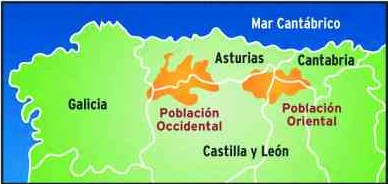The most thorough study carried out so far of the Cantabrian brown bear population, spread over 3 years between 2007 - 2010, has calculated
numbers of between 195 and 210 individuals of which around 150 constitute the western population and around 50 in the east. Previous figures have given, at the most optimistic, 130 and 40 bears respectively.

The study was commissioned by the Asturian government and implemented by biologists of the University of Oviedo with scientists from the national Centro Superior de Investigaciones Científicas (CSIC) analysing samples of faeces and hair collected over a wide area repeating the test areas to find different individuals. Previous censuses were made by calculating the population based on numbers of females with cubs.
According to one of the university scientists, Ana Domínguez, the results show the Cantabrian brown bear population to be viable in the short-term but not in the medium or long-term. The investigators calculate that for a bear population to be really viable and not in danger of extinction there need to be at least 500 breeding adults and with a quarter of any bear population being possibly reproductive that means that for the Cantabrian bears to be completely out of danger there needs to be a population of 2,000 individuals.
The main problem facing the bears is the amount of suitable habitat available for them. Another is their relatively slow rate of reproduction. Javier Naves, one of the biologists leading the study, thinks there is room for the bears to spread into eastern Asturias but the main problem lies in the central area where the two separated populations need to meet. In the centre of the Cordillera Cantábrica there's a high human presence and a low level of habitat protection. (See San Glorio). One of the main keys for the bear population's growth in Asturias has been the high level of protected natural spaces. Naves points out that although these new figures seem promising the existence of bears in these mountains is still not guaranteed and that any changes in the environment or their genetic health would leave them at risk. The challenge for the future is to identify and protect possible corridors between the bear populations while preventing damages to apiculture, agricultural land and livestock.
Another is their relatively slow rate of reproduction. Javier Naves, one of the biologists leading the study, thinks there is room for the bears to spread into eastern Asturias but the main problem lies in the central area where the two separated populations need to meet. In the centre of the Cordillera Cantábrica there's a high human presence and a low level of habitat protection. (See San Glorio). One of the main keys for the bear population's growth in Asturias has been the high level of protected natural spaces. Naves points out that although these new figures seem promising the existence of bears in these mountains is still not guaranteed and that any changes in the environment or their genetic health would leave them at risk. The challenge for the future is to identify and protect possible corridors between the bear populations while preventing damages to apiculture, agricultural land and livestock.
News from lne.es
Here's a video from Fapas showing how bear hair samples can be left stuck to trees after scent-marking.



